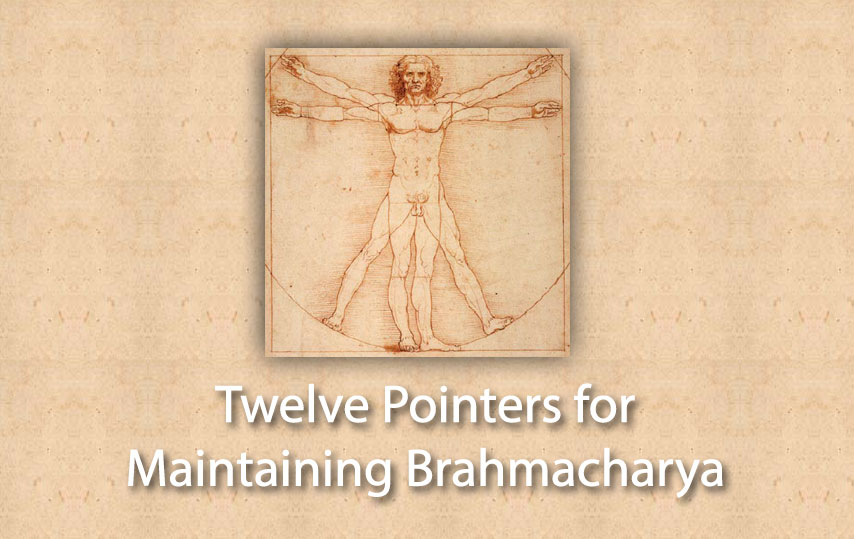1. Daily meditation and constant japa is the essential foundation of brahmacharya. The japa and meditation of the Pranava (Aom) cause the subtle forces known as prana to rise upward. Those who become adept in these spiritual practices will become “urdhvareta yogis” – those in whom the sexual energies ?ow upward and become transmuted into spiritual energies.
2. Satsanga, the company of holy people – or at least those who are aspiring to holiness – is extremely helpful in the maintenance of brahmacharya. If you know like-minded people, then meet with them regularly for spiritual study and conversation. It is not uncommon among both Hindus and Buddhists for spiritual aspirants to meet daily for meditation.
If you do not know any other spiritual aspirants – and this is not uncommon here in the West – then keep satsanga with saints and masters by reading their lives and teachings and keeping their pictures in your home. Holy images of divine forms are also beneficial.
Every day listen to spiritual music. Such music should be soothing and re?ective – not the raucous banging and clanging that many shallow and worldly Christians and Hindus like. It is good to listen to devotional music, but shun merely emotional music, for it is linked to lower desires, no matter how “holy” the words.
3. Avoid asatsanga – the company of the unholy and the worldly – in the form of people who have no interest in spiritual life, as well as books, magazines, television, radio, and motion pictures that are centered on material consciousness. Absolutely avoid those things which deal with the subject of sex or depict sexually suggestive (or outright) matters or images.
4. Avoid casual association with members of the opposite sex. Never be socially alone with a member of the opposite sex. This is an absolute. Make no exceptions based on seemingly spiritual character, age, or intention. When an older woman tells you that she is your “mother”, run away! The same thing applies when a man tells a woman that he is her “father.” This goes on in both India and America, including close – and private – association of men with female gurus and of women with male gurus. No one knows what impulses carried over from previous lives – many even from centuries past – are lying not far beneath the surface of the conscious mind, waiting to manifest. “Spiritual” friendships with members of the opposite sex are doors to disaster. I have seen it over and over. Even in my early teen years, I watched “spiritual” associations inevitably turn into sexual associations. And that had usually been the intention from the ?rst moment. If what I have said does not convince you, at least I have discharged my responsibility.
5. If you happen to be homosexual, then what I say above applies to both sexes. (The number of “gays” that end up fathers is remarkable. It may be cute or poignant on the movie screen, but it is tragic in real life.) In your spiritual associations, try to be sure that there are always several people involved. This is a trial, but many saints and masters have coped with much worse.
6. Avoid absolutely any person or thing that argues against your aspiration to brahmacharya or tries to persuade or force you into sexuality in any form. The “just try it once/for a bit” people are worse than tigers. Run for your life – literally.
7. I have warned you about external factors that harm the life of a brahmachari, but the biggest threat or danger comes from your own mind and impulses. Ruthlessly cut off all overt or oblique thoughts of sex when they rise in your mind. Note what “innocent” subjects of thought “somehow” end up in ideas of sex and banish them the moment they appear in the future.
8. What about “physical needs” and “bodily urges”? Never let them be an excuse for wavering in your ideal. But you must keep the body clean and pure to help you in maintaining brahmacharya.
9. Continuing the previous subject: Diet is an essential factor for the brahmachari and the yogi. Diet is a form of spiritual culture as well as physical culture. There should be total avoidance of animal protein in any form and to any degree whatsoever, and this includes dairy products. Gandhi saw over and over that animal ?esh, animal fats, and dairy products were detrimental to brahmacharya, that movements of lust could be attributed to the physical effects of their use. (This also happens to be the opinion of the Eastern Orthodox Church, especially the monks who watch their minds.) This Hindus screamed “blasphemy” because of their attitude toward cows, but the truth cannot be changed by hysteria. Become not just a vegetarian but a vegan: Eat a diet that is free from all animal protein and fat, dairy products, sugar, and caffeine. Abstain totally from nicotine and alcohol.
To learn the scienti?c and practical basis of what I have advised, see the books of Dr Neal Barnard (http://www.nealbarnard.org) and the information put out by the Physicians Committe For Responsible Medicine (http://www.pcrm.org), Dr Michael Klaper (http://doctorklaper.com), and Dr McDougall (http://www.drmcdougall.com).
10. Food for the mind in the form of spiritual reading is also a tremendous help to the brahmachari. Two books are especially important for the aspiring brahmachari: Meditation and Spiritual Life by Swami Yatiswarananda and Practice of Brahmacharya by Swami Sivananda. This latter book can be downloaded for free from the Divine Life Society website (http://www.dlshq.org/download/ brahmacharya.pdf).
Read the books of many traditions and teachers on spiritual life, taking what is useful and leaving aside what is not. Follow your intuition and don’t get what Yogananda called “spiritual indigestion.”
11. What if you fail in some area or to some degree – or completely? Just keep on trying and be more vigilant. Do not let the ego or foolish associates or “authorities” convince you that it is hopeless, you should not even try, you will not be able, blah, blah, blah … Multitudes of holy people have struggled, some have failed at times, but ALL HAVE SUCCEEDED. So will you.
12. Finally, know that God is on your side. And remember these words of the Bhagavad Gita:
“Though a man be soiled with the sins of a lifetime, let him but love me, rightly resolved, in utter devotion: I see no sinner, that man is holy.
“Holiness soon shall refashion his nature to peace eternal; O son of Kunti, of this be certain: the man that loves me, he shall not perish.
“You find yourself in this transient, joyless world. Turn from it, and take your delight in me.
“Fill your heart and mind with me, adore me, make all your acts an offering to me, bow down to me in self-surrender. If you set your heart upon me thus, and take me for your ideal above all others, you will come into my Being.” (Bhagavad Gita 9:30, 31, 33, 34)


















 Other
Other 

